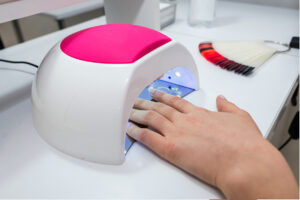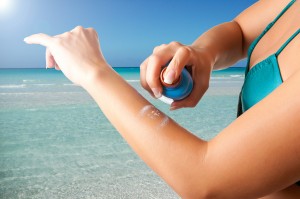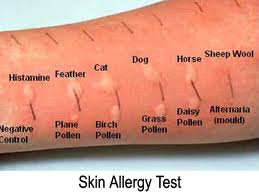A recent publication in Nature Communications found that a common nail salon tool causes skin cancer. The researchers voiced concerns about the use of ultraviolet radiation from nail dryers with gel manicures. They were shown to cause DNA breaks in the exposed skin. The artificial nails require ultraviolet radiation to harden them. But the ultraviolet light hits the skin around the nails and of the fingers, which can be the first step in causing skin cancer.
Three stages in the development of skin cancer
In the 1970’s and 1980’s a lot of basic research using mouse models has been done about 3 stages of skin cancer development. Dr. Kripke was one of the pioneers in this field (see Ref. 1 and 2). However, it turned out later that the human skin is not identical to mouse skin and that human skin seems to be more resistant than that of inbred mice. Nevertheless, the basic concept that was researched then has held up to scrutiny over the ensuing decades. The development of skin cancer in man requires three steps.
1. Initiation
Initiators for skin cancer are UV light, tar, nitrogen mustard, psoralen to name a few. The DNA of skin cells undergoes some configurational changes, but when left alone it does not go on to cancer development.
2. Promotion
Common promoters for the development of skin cancer are: Ultraviolet light, phenol, anthralin, phorbol esters, benzoyl peroxide.
3. Carcinogenic effect
The role of carcinogens in skin cancer is not understood very well. However, the classical studies of scrotal cancer in chimney sweepers pointed to the importance of carcinogens in soot of chimneys (Ref.3). This is one of the first human examples for a carcinogen. Another carcinogen is arsenic. We do not know enough about long-term exposure to small amounts of carcinogenic compounds in drinking water or in polluted air. Other carcinogenic effects are excess radiation from X-rays or irritation from chronic inflammation (lupus lesions, burn scars, decubitus ulcers, chronic osteomyelitis). Repeated exposure to UV light also has carcinogenic effects on the skin by leading to DNA breaks. UV light exposure plays an important part in every step of skin cancer development.
More causes of skin cancer
Squamous cell cancer of the oral cavity and lip has been linked to chewing tobacco or betel nuts. There is also a link to certain viruses such as the human papillomavirus. This model for cancer development is applicable for many other cancers, if not for all forms of cancer. Many stabilizers and antimicrobial/antifungal substances such as parabens are also mild carcinogens. Many physicians warn their patients not to use parabens in tooth paste, cosmetics, shampoos, conditioners and body wash products. I agree with this opinion. Go to a health food store and get alternative products without parabens in it. Read labels! Numerous paraben-free products are also on the shelves of drugstores. If you read the word ”paraben”, leave the product on the shelf. Exposure to UV light and several sunburns in succession can also cause skin cancer.
Common nail salon tool causes skin cancer: further discussion
Ludmil B. Alexandrov holds dual titles as associate professor of bioengineering and cellular and molecular medicine at the University of California San Diego. He said: ”If you look at the way these devices are presented, they are marketed as safe, with nothing to be concerned about. But to the best of our knowledge, no one has actually studied these devices and how they affect human cells at the molecular and cellular levels until now.” Those who want to continue gel manicures, can use some precautions to minimize the risk of skin cancer. Use a sunblock that contains zinc and titanium on the skin of your fingers around the nails. This will block the damaging UV rays. But the safest way is to stop using nail dryers, which are necessary with gel manicures.
Conclusion
We sometimes lose sight of what modern procedures can do to us. One example is the use of gel manicures that require exposure to UV light to harden the gel nail polish. Several layers are applied during a manicure session. Most people do not think that the accumulated exposure to UV light can lead to DNA breaks and eventually cause skin cancer. But dermatologists have noted that there is a direct link between the amount of UV light exposure and the risk to develop skin cancer later in life.
Prevention of UV light exposure
The logical conclusion is to stop using these applications of gel nail polish. However, if the person finds it difficult to abandon this manicure procedure, a compromise is to cover up the skin of your fingers with a sunblock that contains zinc and titanium. You can apply this to the skin of your fingers around the nails. To a certain extent this will block the damaging UV rays, but it is not a guarantee.
References
- Kripke ML, Sass ER,eds.”Antigenicity of murine skin tumors induced by UV light”.JNCI 1974;53:1333-1336.
- Kripke ML. “Immunology and photocarcinogenenis”. J. Am. Acad.Dermatol. 1986;14:149-155.
- Potter M.”Percivall Pott’s contribution to cancer research”. NCI Monogr.1963;10:1.









